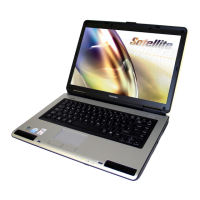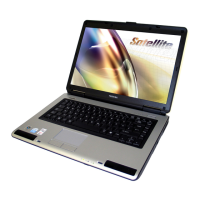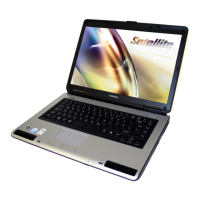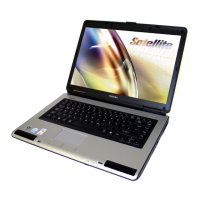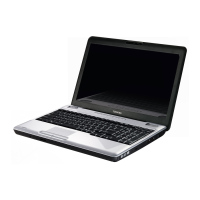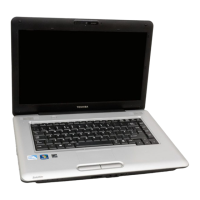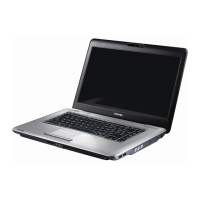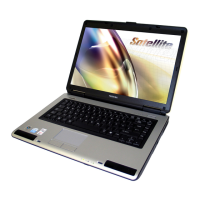
Do you have a question about the Toshiba L40 Series and is the answer not in the manual?
| Processor | Intel Core i3/i5 |
|---|---|
| RAM | 8GB DDR3 |
| Storage | 128GB/256GB SSD |
| Display | 14-inch HD (1366x768) |
| Graphics | Intel HD Graphics |
| Operating System | Windows 8.1/Windows 10 (depending on model) |
| Battery | Up to 6 hours |
| Optical Drive | DVD SuperMulti |
| Connectivity | Wi-Fi 802.11 b/g/n, Bluetooth 4.0 |
| Ports | USB 2.0/3.0, HDMI, VGA, Ethernet, SD card reader, headphone/microphone combo jack |
Identifies the computer's special features, options, and accessories.
Details processor options and chipset components like Mobile Intel GL960 Express Chipset.
Describes main memory configuration and BIOS features.
Covers battery pack specifications, RTC battery, and power-related disclaimers.
Details AC adapter, TouchPad, LCD display, and graphics controller.
Describes fixed hard disk options and CD-RW/DVD-ROM drives.
Covers Express Card, media card slots, ports, and communication options.
Explains security lock slots, hotkeys, power-on passwords, and battery save modes.
Lists and describes pre-installed software utilities like TOSHIBA Assist and DVD Player.
Lists available options such as memory modules, battery packs, and AC adapters.
Identifies front panel components like LEDs and switches when the display is closed.
Details ports and indicators on the right side of the computer.
Describes the optical disc drive and associated LED on the left side.
Identifies ports and fan vents on the computer's back panel.
Details the battery pack, lock, latch, and expansion memory socket on the underside.
Identifies the display screen, power button, keyboard, and touchpad.
Explains the function of Caps Lock, Numeric, and Scroll Lock mode indicators.
Provides information on optical disc drives and their access indicators.
Guides on connecting the AC adapter and opening the computer's display.
Instructions for turning on the computer and initial setup for first-time use.
Explains different ways to turn off the computer: Shutdown, Sleep, and Hibernation.
Details benefits, limitations, and execution of Sleep and Hibernation modes.
Describes how to restart the computer and use System Recovery Options.
Guides on restoring preinstalled software using the Product Recovery disc.
Explains how to use the TouchPad and its control buttons for navigation.
Guides on setting up and using the internal modem for data and fax communication.
Details connecting to LAN, troubleshooting Wireless LAN, and security settings.
Explains how to load, remove, and use optical disc drives.
Provides instructions and precautions for writing CDs/DVDs on various drives.
Offers tips on protecting discs and disks, and cleaning the computer.
Guides on setting up multiple displays and adjusting display settings.
Provides advice on cleaning and moving the computer safely.
Describes typewriter keys, function keys, soft keys, and Windows special keys.
Explains the F1 through F12 function keys and their programmed functions.
Details Fn key combinations for soft keys and keyboard emulation.
Lists hotkeys for system control and Windows special keys.
Explains how to use the numeric keypad overlay and switch modes.
Guides on generating ASCII characters using keyboard shortcuts.
Explains power indicators (Battery, DC IN, Power) and battery status lights.
Provides guidance on battery pack care, safety precautions, and disposal.
Details the procedure for removing and installing the battery pack.
Describes the computer's power-up modes: Hibernation, Sleep, and Boot.
Explains how the system automatically turns off in Sleep or Hibernation mode.
Covers Express Cards and SD/SDHC/MMC/MS/MS Pro/xD memory cards.
Details additional battery packs and AC adapters.
Lists external monitors and security locks as peripheral options.
Guides on installing and removing an Express Card.
Explains installing, removing, and caring for memory cards.
Details how to install additional memory modules for system expansion.
Guides on connecting an external analog monitor to the computer.
Steps to identify and resolve computer problems effectively.
Simple troubleshooting steps like checking cables and peripheral devices.
Questions to help identify malfunctions in hardware or software.
Checklists for common problems related to system startup, power, and peripherals.
Troubleshooting steps for AC power and battery-related problems.
Solutions for keyboard issues like incorrect number input or garbled output.
Troubleshooting steps for battery not powering or charging problems.
Addresses problems with hard disk drives and LCD panels.
Troubleshoots issues with Wireless LAN, PC Cards, and external monitors.
Solves problems with the TouchPad and USB mouse.
Addresses memory expansion errors and problems entering Sleep/Hibernation.
Provides guidance on contacting TOSHIBA for technical assistance.
States conditions that may affect CPU performance variations.
Disclaimers regarding main system memory usage and battery life variations.
Disclaimers on HDD capacity reporting and LCD screen brightness deterioration.
Disclaimers on GPU performance and wireless LAN transmission speeds.
Covers non-applicable icons, copy protection, images, and eye strain.
Provides the physical dimensions of the notebook PC.
Details the computer's weight and environmental operating requirements.
Lists specifications for the built-in modem, including NCU and protocol details.
Details communication speeds, error correction, and data compression standards.
Lists CRT display resolutions, color depth, and refresh rates for external monitors.
Details power cord length, wire size, current, and voltage ratings.
Lists certification agencies for AC power cords in various regions.
Provides information on reporting a stolen computer and registration steps.
